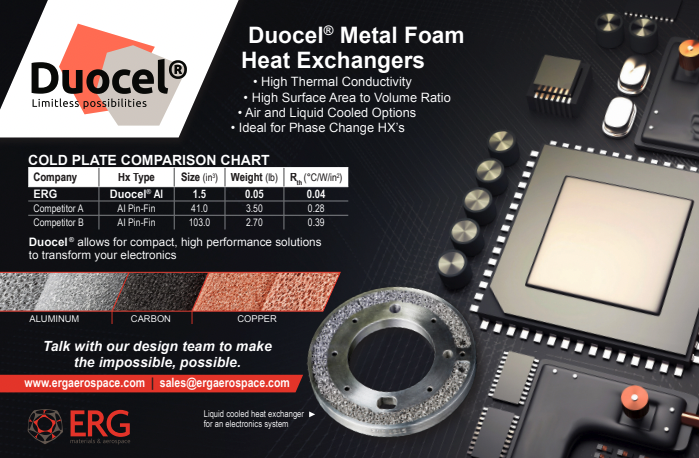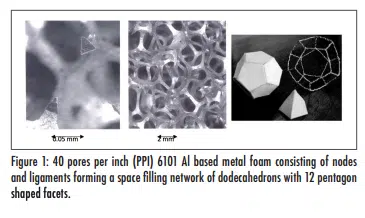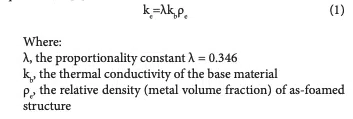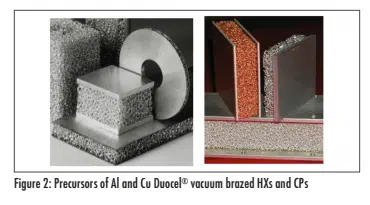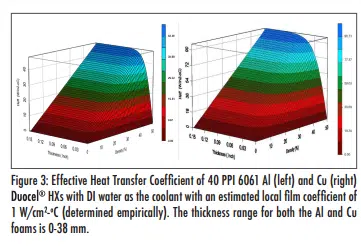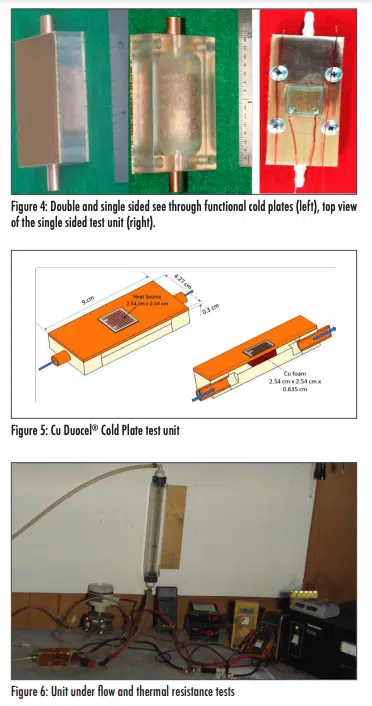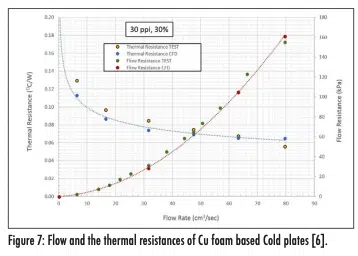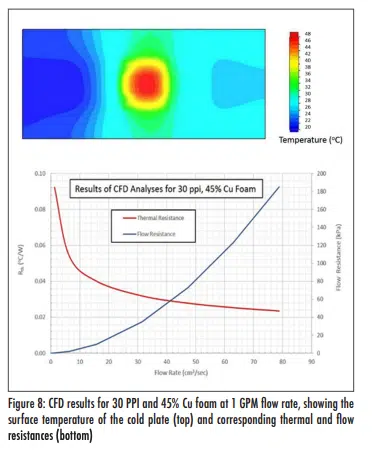Introduction
As power-component technology advances and smaller packaging is required, thermal-management issues threaten to limit the performance of devices. As power dissipation rises, the inability to cool them may force designers to de-rate the devices’ performance by reducing current or switching speed and/or employing higher-voltage devices that are less efficient and more expensive. These compromises in design may increase the size, weight, or cost of the application.
A proven approach is to transfer higher heat fluxes to ambient by improving the performance of the heat sink and reducing or eliminating soft thermal interfaces. One technology capable of accomplishing these goals employs a class of materials known as metal foams. One specific type of high-performance metal foam is Duocel®, a solid ligament, open celled metal foam manufactured by ERG Aerospace. The material was developed more than 50 years ago for structural applications, and is being applied effectively to thermal-management problems in electronic systems.
Unlike conventional finned heatsinks, Duocel®-based heatsinks consist of blocks that are either brazed or soldered to a substrate material. When compared with finned heat sinks, these heatsinks offer improved thermal performance, smaller size, lighter weight, lower cost versus performance among other advantages.
Duocel® is a proven, cost-effective and ultra-high-performance thermal management material that can be integrated with electronic devices and modules. It is also compatible with traditional coolants used in heat exchanger for electronic devices, making it an ideal candidate for cold plates and liquid cooled applications.
STRUCTURE OF DUOCEL®
There are several types of metal foams. This paper focuses on solid ligament, open celled metal foams, known as Duocel® manufactured by ERG Aerospace. Solid ligament, open cell metal foams offer significant structural and thermal properties compared to 3D printed or sintered foam structures, which often have weak or hollow ligaments. In the as-fabricated state, the isotropic structure consists of randomly oriented polygon shaped cells that can be approximated as dodecahedron, Figure 1 [2,3,4]. Notice that the cross sections of roughly 2 mm long solid ligaments are mostly triangular. The geometry of the cell structure and the high purity and ductility of its solid ligament metal produce the most desirable characteristics for heat exchanger (HX) applications. The physical dimensions of its structure, as shown below, does not allow boundary layers to grow and introduce enhanced mixing through eddies and turbulence. These features result in a high local film coefficient.
Open cell, solid ligament metal foams are commonly produced in aluminum and copper, and have controllable pore size (5, 10, 20 and 40 pores per inch (PPI)) and customizable relative density of 4-13% (a.k.a. volume fraction). Due to the solid ligament’s high ductility, they can be compressed to 50% relative density through mechanical compression, further enhancing the thermal performance per unit volume. The important parameters of Duocel® are thermal conductivity, heat transfer surface area, high mechanical ductility and compliance.
THERMAL CONDUCTIVITY
The foam manufacturing process preserves the high purity of the material in the structure. The thermal conductivity of 6101 Al and C10100 Cu, most common base materials, are about 215 W/m-K and 390 W/m-K, respectively. The effective bulk thermal conductivity, however, depends on the porosity of the foam RMF’s effective bulk conductivity (ke ) and may be estimated by Equation (1) [2].
The effective bulk conductivity of an 8% relative density 6101 Al Duocel® is about 6 W/m-K. Due to their high ductility, it can undergo significant inelastic and elastic buckling deformations without failure of the solid ligaments, resulting in an increase in the relative density of the foam structure up to 50%. Since the thermal conductivity is a vector quantity, its value will be a function of not just the amount of compression (as it is for the effective surface area), but also of the direction of compression. The effective thermal conductivity of 6101 Al based foams biaxially increases to ~ 40 W/m-K, when unidirectionally compressed in X direction to 50% relative density in the (YZ) plane where ligaments are aligned in Y and Z directions. The amount and direction of compression, as well as the initial pore size and relative density, are the variables that allow the properties of Duocel® to be tailored to a given application, creating a heat sink with performance optimized for the application.
SURFACE AREA DENSITY
One of the most important features of the metal foams is their extremely high and scalable surface area density (ρs ) compare to those of brazed or extruded fins and fin pins. ρs is directly related to the extended surface area for improved convective heat transfer. The ρs of Duocel® was characterized using experimental measurements, by multipoint Brunauer, Emmett, and Teller (BET) method by adsorption of krypton gas at 77.4 K, and the modelling studies by authors.
The results of these studies showed that ρs of 40 PPI metal foam at as fabricated 6% and compressed 50% state are about 15.5 cm2 / cm3 (40 in2 /in3 ) and 138 cm2 /cm3 (350 in2 /in3 ), respectively [2,3].
CONVECTIVE FILM COEFFICIENTS
The mostly triangular cross section and only a couple of millimeter long ligament geometry of Duocel® offers significant advantages in convective cooling. It scales down the thickness of boundary layers, generates vortices, and induces turbulence. In two-phase flow applications, it also delays or eliminates the transition from nucleate boiling to film boiling. The net outcome is enhanced heat transfer due to high local film coefficients.
THERMAL INTERFACES
A metal foam based compact HX can be integrated to the sources of heat generation via solder bonding. Integration eliminates the highly resistive thermal interfaces of soft materials such as thermal pads, pastes, or thermal epoxies commonly used to couple discrete devices, hybrid multi-chip modules (HMCM) of photonic and electronic devices. Duocel® may be brazed to low expansion skin layers and function as a constraining double-sided core heat exchanger (HX) for printed wiring boards (PWBs).
The metal foam structure has a very high effective compliance, [2] that allows metallurgical bonding to the foam by soldering or brazing to low CTE materials (metalized ceramic plates, low expansion composites, Mo, and CuMoCu, among others). Since the CTE mismatch related thermal stresses and deformations are limited, the reliability of the integral heat exchanger and the thermal base is not compromised, as verified by several hundreds of thermal cycles [5].
FABRICATION OF METAL FOAM HEAT EXCHANGERS
Method of manufacturing of Duocel® based heat exchangers depends on the material and the design. Aluminum RMF based HXs can be fabricated with vacuum or dip brazing. Fully enclosed HX/ cold plate (CP) configurations require vacuum brazing using solid braze preforms. HXs with exposed metal foam can be fabricated by either dip brazing or vacuum brazing. The open cell structure of RMF allows cleaning of any residual salt left over from the dip brazing bath. The advantage of vacuum brazing however becomes apparent for manufacturing in larger quantities. Use of a vacuum furnace may accommodate hundreds of units in a single batch operation at a lower cost per unit.
The fabrication of Cu foam-based heat exchangers where Cu foam is bonded to a Cu plate of enclosed housing are fabricated with inert-atmosphere, high-temperature brazing or vacuum brazing furnaces with suitable Cu-Ag solid braze preforms. Solder pastes may be used to fabricate CPs in inert-atmosphere furnaces where the structure is exposed. Figure 2 shows a variety of 6101 aluminum foam-based articles made by vacuum brazing [6].
ANALYTICAL STUDY OF THERMAL PERFORMANCE
The major factors scaling the thermal performance of Duocel® HX are:
• Thermal conductivity of the base material (Al, Cu, Ag, or others).
• Pore size measured as PPI, the linear density of pores per inch (5-40 ppi).
• Relative density (5% to ~50%)
• Physical thickness (impacts fin efficiency similar to fin length)
• Thermo-physical properties of the coolant
Improved heat transfer performance due to RMF can be analyzed in a similar fashion to conventional HX and can be quantified in terms of an equivalent flat plate effective heat transfer coefficient (Heff ) based on the footprint area of the cooling unit. Figure 3 [2] illustrates the trends and magnitudes of Heff for forced convection using distilled water as the coolant with an estimated local film coefficient of 1 W/cm2 -o C (determined empirically). Effective film coefficient is a strong function of relative density, while asymptotically approaching a saturation value with increased thickness in a manner analogous to fin efficiency. This parametric analysis assumed idealized 1D conduction, but more complex scenarios can readily be tackled using conjugate heat transfer CFD modeling and appropriately defined porous media properties.
EXPERIMENTAL STUDY OF THERMAL PERFORMANCE
To demonstrate the cooling capability of Duocel®, a test module was fabricated by inert atmosphere brazing a 1.00” x 1.00” x 0.250” block of Duocel® copper foam to the center of a 2.00” x 2.00” x 0.125” thick Cu plate. A Plexiglas housing of the same cavity depth was fabricated out of a 0.25” thick Plexiglas sheet and screwed to the Cu plate with cork gasket. A 1.00” x 1.00” resistor was eutectic Sn/Pb soldered on the center of the Cu plate in inert gas environment. The cold plate test unit is depicted in Figures 4 and 5.
The flow rate and the inlet temperature of the inlet DI water were kept constant using a recirculating chiller. The heater power, volume flow rate, inlet, and exit temperature of the coolant were monitored via multimeter current and voltage measurements, flow meter, and thermocouples, respectively. The surface temperature of the cold plate was estimated by the temperature measurements with thermocouples on the resistor. This experimental setup is shown in Figure 6.
The results are presented in Figure (7) in terms of thermal resistance, which is commonly defined by Equation (2):
where
Q: Power dissipated by the heater/device (W)
ΔT: Temperature difference between the maximum surface temperature of the CP and the average temperature of the coolant, as calculated by Equation (3)
Cp : Heat capacity of coolant (J/kg-o C)
(m🙂 Mass flow rate of coolant (kg/sec)
The experimental results in Figure (7) show excellent agreement with the CFD analysis, validating the modeling approach. The subsequent case study will give more context for the measured and predicted performance numbers.
CASE STUDY ON HIGH POWER ELECTRONICS DEVICE COLD PLATE
In the early stages of design, the feasibility of a given cold plate technology for a high-power electronics device may be assessed by its thermal resistance (Rth). Consider the application of cooling a 1” x 1” device that dissipates 1 kW of heat. Assume the max allowable temperature of TMax=60o C, and the available cooling flow is DI water (ρw=1,000 kg/m3 , CP=4,184 J/kg-o C) at a volume flow rate of V=1.0 GPM (6.3*10-5 m3 /sec) and Tin=21o C. Using Equations (2) and (3), the required thermal resistance is 0.037 o C/W.
High performance micro channel type Cu cold plates are only able to deliver 0.05o C/W under these conditions, which would be insufficient for the present application. Meanwhile a Duocel® based cold plate can be tailored to achieve the goal with a healthy margin using a 40 PPI, 45% dense copper foam cold plate, as demonstrated by the CFD results in Figure 8.
SUMMARY AND DISCUSSIONS
Studies show that open cell, solid ligament Duocel® based CP and HXs offer high thermal performance due to their extremely high specific surface area, local film coefficients, and thermal conductivity particularly for lower volume and weight applications. The structure can be customized to meet a wide range of thermal requirements making them a versatile solution.
Metal foams demonstrate compatibility with a wide range of liquids and gaseous coolants, which makes the technology advantageously suitable for a wide range of commercial and military applications. The structural and thermal characteristics of RMF foams also offers similar advantages in passive phase change and two-phase flow applications.
ACKNOWLEDGEMENTS
Authors would like to take this opportunity to express their gratitude to Mitchell Hall, the CEO of ERG Aerospace, for his support, encouragement, and directions in the research and the publication of this work.
REFERENCES
1. Ashby, M. F. et al. “Metal Foams – A Design Guide”, Butterworth Heinemann, pp. 6-20, 2000.
2. B. Ozmat et al., “Thermal Applications of Open Cell Metal Foams” Materials and Manufacturing Processes, Special Edition, Vol.19, No. 5, pp. 839-862, 2004
3. Brunauer, Emmet, Teller, Journal of the American Chemical Society, Volume 60, 1938, p 309.
4. Sorgo M., “Thermal Interface Materials,” Electronics Cooling, Vol. 2, No. 3, pp. 12 -16., Sept. 1996.
5. Final Program Report, COMNAVSEASYSCOM contract N00024-94-NR58001.
6. The metal foam used in the fabrication of these cold plates is marketed under the trade name Duocel®, ergaerospace.com
